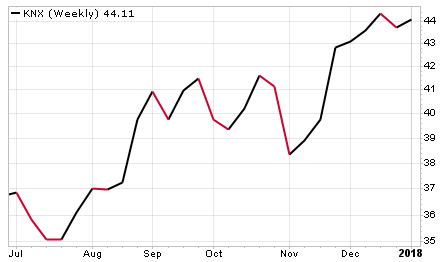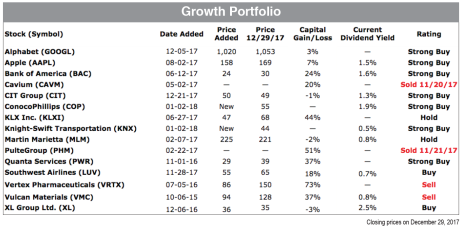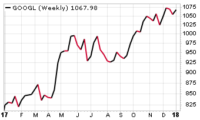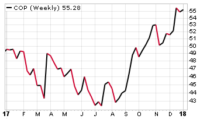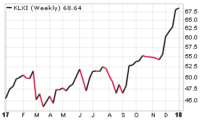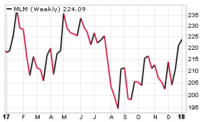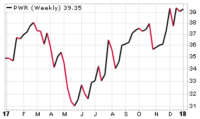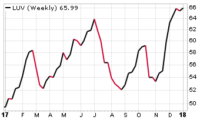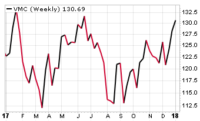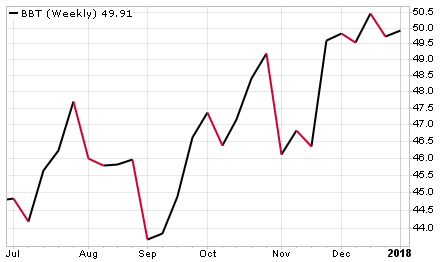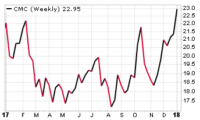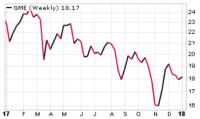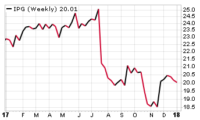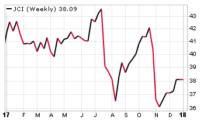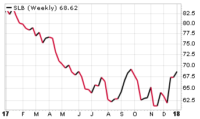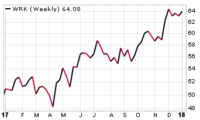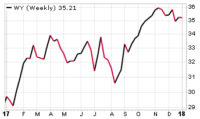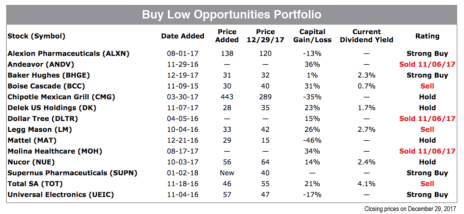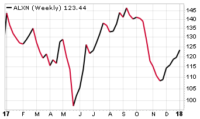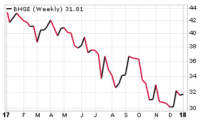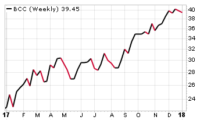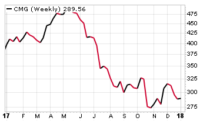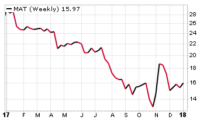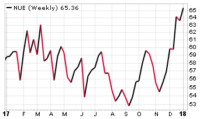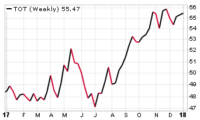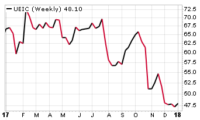There are many changes in today’s issue: we’re adding four new stocks and selling seven stocks.
Cabot Undervalued Stocks Advisor 118
[premium_html_toc post_id="142830"]
Happy New Year!
Warning: I’m buying and selling 11 stocks today.
It’s hard to send holiday greetings to a broad audience, because different people celebrate different holidays, but today is the second day of a new year for me, and I’m excited about that. I think huge changes are coming, and I love change!
As a matter of fact, I was so excited about saying goodbye to the past and embracing the future that I decided to buy and sell many stocks today. I hope I don’t alarm you! There has been no sudden bad news that’s caused me to sell various stocks. I itemize them in the coming pages and let you know their prospects whether I continue to hold them in the Cabot Undervalued Stocks Advisor portfolios or not. You see, I recently finished a review of 1,032 stocks. There are lots of good investments in that stock universe, and it’s frustrating to bypass them week after week. So I decided to forge ahead with removing some portfolio stocks that are close to their price targets, have slowing growth prospects or full valuations, in order to offer you more variety and more frequent investment choices.
These are the sectors and industries where I see growth and value in the coming year: energy (all industries, including chemicals), finance (especially mid-cap banks, property & casualty insurance and reinsurance), biotech stocks, and a wide variety of basic materials, building materials, construction and engineering stocks. Be cautious with last year’s winning semiconductor stocks because there’s not a single one currently on my buy list, meaning that their earnings per share (EPS) growth has slowed dramatically and/or their price/earnings ratios (P/Es) have risen into overvalued territory. You can always protect yourself with stop loss orders. After they sell, though, don’t look back. The future is in front of you.
I anticipate selling a few more stocks in January, with a specific focus on 2017 laggards that don’t begin to rebound this month. If you choose to continue to own stocks that have been removed from these portfolios, I don’t mind if you send me the occasional email asking about their current prospects. (Just don’t send me a list of 20 stocks to review, okay? I can’t take on that role. I’m sure you understand.)
As long as we’re mentioning stocks that used to be in the Cabot Undervalued Stocks Advisor portfolios, I want to mention TiVo (TIVO – yield 4.6%). I sold TIVO in August 2017 because the company was not reporting quarterly results in the standard fashion, and the anomaly was causing significant upheaval in the share price. As much as I liked the company, its growth prospects and its attractiveness as a buyout target, the reporting problem compelled me to sell.
On December 29, it was revealed that TiVo has received inquiries from various parties that are interested in purchasing the company. Naturally, the share price subsequently shot up, exactly as we saw recently with KLX Inc. (KLXI). At this point in time, analysts expect TiVo to see EPS grow very aggressively at 42.9% in 2018, while the P/E is just 6.9. Yes, there’s a shocking disparity between those two numbers, enhanced by the large dividend yield. If I had to hazard a guess, I’d say that the buyout value is somewhere over $20 per share—possibly much higher. I’ll leave it at that for now.
It seems that Wall Street took a collective vacation last week because there were barely any new research reports and our only portfolio stock that had earnings estimates that moved more than a penny per share was Delek Holdings (DK – yield 1.7%). In addition, almost nothing happened with pricing. Lots of our stocks are trading quietly sideways, likely resting after November and December run-ups (or drops, as the case may be). Note that the rising earnings estimates on Delek are extremely bullish, especially because that’s not the general pattern throughout the stock market.
Sometimes I reiterate important points because I don’t want any investors to miss significant opportunities. At some point in the coming months, I expect a price correction in U.S. stock markets. It’s not that I think there’s anything terribly wrong, nor that stocks are overvalued. It’s just that markets don’t generally climb and climb and climb without periodically adjusting. We’re overdue for that adjustment. Make sure you have cash set aside with which to buy low! I’ll give you the buy signal when the time comes.
The stocks that I’m most cautious about heading into a market correction are stocks of retail asset manager companies, including discount brokers. These include Ameriprise Financial (AMP), Charles Schwab (SCHW), Eaton Vance (EV), Legg Mason (LM), T Rowe Price (TROW) and many others. I believe that these stocks will fall further than the broader market, and that they’ll take longer to recover. I won’t mind buying them after their share prices fall and stabilize, but I certainly don’t want to own them prior to the correction. With this in mind, I’m selling Legg Mason (LM – yield 2.7%) today.
The Energy Sector
The U.S. oil rig count rose from 525 rigs at year-end 2016 to 747 rigs at year-end 2017, a 42% year-over-year increase. Rising oil prices paved the way for increased spending by energy companies, causing ongoing aggressive earnings growth at oilfield service companies. As I’ve mentioned repeatedly, oilfield service companies’ stocks did not participate in the 2017 bull market. It’s not too late to position your portfolio in that industry, where I’m expecting outsized capital gains in 2018.
The only sector with rapidly-rising earnings estimates last week was the energy sector. That was certainly the case with Delek Holdings (DK – yield 1.7%) in the Buy Low Opportunities Portfolio, but also the case with Pioneer Natural Resources (PXD – yield 0.1%), a U.S. energy exploration and production (E&P) company that’s featured in OilPrice.com’s Oil Giants Are Increasingly Focused on Sustainability. It’s fairly common for me to run across articles detailing the efforts that energy companies are making in order to mitigate their impacts on the environment. You might not see such articles very often via mainstream media—especially media with a strong political bias—but if that topic is of interest to you, OilPrice.com is an excellent resource.
Pioneer Natural Resources has been on my “waiting in the wings” list since September, but the timing was never quite right to add it to the Cabot Undervalued Stocks Advisor portfolios. In case you’d like to add it to your watch list, the stock features a high P/E, huge earnings growth rates (both in 2018 and 2019) and low debt levels.
Here’s some global energy insight from a December 26 CNBC interview with Wolfe Research analyst Paul Sankey. The following are some comments from Mr. Sankey and my commentary:
Demand for oil “is raging globally.” “The [energy stock] sector should do a lot better” in 2018.
“We still adore EOG … the best management structure, the best systems,” referring to EOG Resources (EOG – yield 0.6%). He said “adore!” I don’t know about you, but listening to a serious financial professional use the word “adore” just made me giggle and love him to pieces. Mr. Sankey is hopeful for a dividend increase and/or share buybacks. EOG has been on my “waiting in the wings” list since July 2017. I recommended the stock to the investors who attended the Cabot Wealth Summit in September 2017, and it’s up about 17% since then. Like Pioneer Natural Resources, the stock features a high P/E and an even higher earnings growth rate.
“We prefer Chevron (CVX – yield 3.4%) over Exxon (XOM – yield 3.7%).” Mr. Sankey warns of long-term Russia problems at XOM. In my opinion, CVX is undervalued while XOM is fully valued.
“We like the yield of the European guys as well.” Presumably Mr. Sankey is recommending BP, Total, Eni and/or Royal Dutch Shell, although he didn’t specify any of those until the topic turned to natural gas, at which time he recommended Royal Dutch Shell (RDS.A – yield 4.8%)—yet another attractive growth & income stock.
Curiously, Mr. Sankey is “critical of Pioneer (PXD),” which the OilPrice.com article raved over.
I also considered adding Devon Energy (DVN – 0.6%) to the portfolios today. It’s a fine North American E&P company, with multiple years of strong earnings growth in Wall Street’s forecast and a low P/E. But after reviewing a dozen attractive E&P companies, I decided to add ConocoPhillips (COP – yield 1.9%, Strong Buy) to the Growth Portfolio today, a worldwide E&P company. As long as global energy demand is “raging,” I want to remain positioned to capitalize on it.
The interesting thing about COP is that it has features that would qualify its addition to any of the three Cabot Undervalued Stocks Advisor portfolios. I spent quite a bit of time pondering which portfolio to add it to. So even though I chose the Growth Portfolio, rest assured that COP is also very much a “buy low opportunity” with a nice dividend yield.
Here are the EPS numbers from 2016 through 2018: (-$2.66), $0.53 and $1.71. The market’s essentially expecting 236% EPS growth in 2018, and the P/E is 32.1. This kind of EPS vs. P/E disparity exists throughout the energy sector. I admit that you could practically throw darts at a list of energy stocks and enjoy attractive capital gains in 2018, which is one reason why I discuss so many E&P companies today.
If you pull up a five-year price chart on COP, you’ll notice that the stock rose as high as 77.5 in July 2014, then proceeded to lose more than half its value. Similar to stocks throughout the sector, the rebound has long since begun. I would buy COP now, and not hem and haw and try to save a dollar per share. There’s 40% upside as the stock retraces its former high, at which time I will sell. Strong Buy.
An Eventual Stock Market Correction and Rebound
Are you raising cash in your portfolio so that you can buy low when a stock market correction rolls around? I hope so. Imagine the frustration of being fully invested at such a time vs. the gleeful shopping spree if you had cash available to purchase stock bargains. Send me an email and tell me that you’re readying yourself for that opportunity!
One more thing: unless you’re an adept trader, please don’t sell stocks of high quality companies during stock market corrections. The market will rebound and you’ll be left in the dust, sitting in cash, no longer owning those great companies. That’s a rookie mistake, meaning that you’re not allowed to let it happen more than once in your lifetime!
Send questions and comments to crista@cabotwealth.com.
Portfolio Notes
Be sure to review the December 27 Special Bulletin, in which I mentioned news, rating changes and/or price action on BP plc (BP), Delek Holdings (DK), KLX Inc. (KLXI), Martin Marietta Materials (MLM), Vertex Pharmaceuticals (VRTX) and Vulcan Materials (VMC).
Buy-Rated Stocks Most Likely* To Rise More Than 5% Near-Term:
Alexion Pharmaceuticals (ALXN)
Baker Hughes (BHGE)
Supernus Pharmaceuticals (SUPN)
Universal Electronics (UEIC)
*I can review price charts and make an educated determination about what’s likely to occur, but I will sometimes be wrong. I cannot control the stock market; I can only guide you through it.
Today’s Portfolio Changes:
BB&T Corp. (BBT) joins the Growth & Income Portfolio as a Strong Buy.
Boise Cascade (BCC) moves from Hold to Sell.
ConocoPhillips (COP) joins the Growth Portfolio as a Strong Buy.
Johnson Controls (JCI) moves from Hold to Sell.
Knight-Swift Transportation Holdings (KNX) joins the Growth Portfolio as a Strong Buy.
Legg Mason (LM) moves from Hold to Sell.
Morgan Stanley (MS) moves from Hold to Strong Buy.
Supernus Pharmaceuticals (SUPN) joins the Buy Low Opportunities Portfolio as a Strong Buy.
Total SA (TOT) moves from Hold to Sell.
Vertex Pharmaceuticals (VRTX) moves from Hold to Sell.
Vulcan Materials (VMC) moves from Hold to Sell.
Weyerhaeuser (WY) moves from Hold to Sell.
Last Week’s Portfolio Changes:
BP plc (BP) was sold from the Growth & Income Portfolio on December 27.
Delek Holdings (DK) moved from Buy to Hold.
KLX Inc. (KLXI) moved from Strong Buy to Hold.
Martin Marietta Materials (MLM) moved from Strong Buy to Hold.
Vertex Pharmaceuticals (VRTX) moved from Strong Buy to Hold.
Vulcan Materials (VMC) moved from Buy to Hold.
Growth Portfolio
Growth Portfolio stocks have bullish charts, strong projected earnings growth, little or no dividends, low-to-moderate P/Es (price/earnings ratios) and low-to-moderate debt levels.
Featured Stock: Knight-Swift Transportation Holdings (KNX - yield 0.5%)
Knight Transportation and Swift Transportation Company merged in September 2017 to form the largest U.S. truckload carrier. The new company’s management team is widely respected. Post-merger cost synergies and efficiencies (especially in the Swift business), and increases in fuel surcharges, trucking rates and volumes are all contributing to a multi-year surge in profits. The biggest current industry phenomena are that both trucking supply and demand have been trending far higher than normal, and that December 31 marked the first major deadline for a new requirement that companies and drivers use electronic logging devices (ELDs) to log hours of service (HOS).
It’s typical that Wall Street analysts are conservative in their earnings estimates after big corporate mergers, while awaiting a few quarters of combined-company results. Yet despite traditional caution, consensus estimates point to EPS growing 43.8% and 27.0% in 2018 and 2019 (December year-end)! The corresponding P/Es are low in comparison at 25.1 and 19.8. The tiny dividend has remained unchanged for many years.
The stock will likely react well to the growing U.S. economy, aggressive EPS growth and quarterly financial results that build investors’ confidence in Knight-Swift management’s ability to achieve merger-related goals. KNX rose above price resistance at 41.5 in late November, but has only very-gradually risen since then. Buy KNX now before the advance kicks into gear. Strong Buy.
Updates on Growth Portfolio Stocks
Alphabet Cl. A (GOOGL) is the world’s largest internet company. Revenue is derived from Google’s online ads, with the balance coming from the sale of apps, digital content, services, licensing and hardware. GOOGL is an undervalued, large-cap aggressive growth stock. EPS are expected to grow 28.6% in 2018, with a P/E of 25.3. I expect the current run-up to continue. Buy GOOGL on the current pullback. Strong Buy.
Apple (AAPL – yield 1.5%) manufactures a wide range of popular communication and music devices. Apple is expected to grow EPS by 24.4% in fiscal 2018 (September year-end), and the P/E is 14.8, presenting an attractive growth and value scenario. Earnings estimates rose throughout 2017. Buy AAPL now before the next run-up begins. Strong Buy.
Bank of America (BAC – yield 1.6%) – Analysts expect EPS to grow 21.5% in 2018, with a P/E of 13.4. Over the course of the next several years, all the following phenomena can serve to push earnings estimates higher: lower income tax rates, higher interest rates, deregulation and a growing U.S. economy. BAC is up 20% since it began this run-up in late September. Realistically, the stock’s going to have to rest soon. I expect additional capital gains from BAC in 2018. Buy on dips. Strong Buy.
CIT Group (CIT – yield 1.3%) operates both a bank holding company and a financial holding company that provide financing, leasing and advisory services to small and middle-market businesses, consumer markets, and the real estate and railroad industries. CIT is one of my two top stock picks for 2018. Analysts expect EPS to grow 20.6% in 2018, with a P/E of 14.0. CIT is an undervalued, mid-cap growth stock. The stock surpassed long-term price resistance at 50 on December 4, then had a small pullback to recent price support at 49. Buy CIT now. Strong Buy.
ConocoPhillips (COP – yield 1.9%) – (See the recommendation in the intro, above.) Strong Buy.
KLX Inc. (KLXI) is a small-cap growth stock in the aerospace and energy services industries. Analysts expect EPS to grow 25.0% in 2019 (January year-end) with a P/E of 17.3. KLX has been approached by several companies that are interested in buying all or part of KLX. KLX hired Goldman Sachs in December to handle the potential M&A transaction. Odds are strong that an offer will be made by an interested party and the KLXI share price will rise further. I have no point of reference with which to estimate the stock’s buyout value, but for what it’s worth, investment bank SunTrust Robinson Humphrey raised their price target on KLXI to 78 last week. The stock’s up 44% since joining the portfolio in June. Consider using a stop loss order to protect your gain. Hold.
Martin Marietta Materials (MLM – yield 0.8%) is a supplier of crushed stone, sand, gravel, cement, concrete and asphalt. Analysts expect profits to grow 29.0% in 2018, with a P/E of 25.3. MLM is Morningstar’s top pick for U.S. infrastructure. MLM and its peers (VMC and EXP) rose last week. MLM has 8% upside as its retraces its May 2017 peak at 240, where the stock will still be undervalued. Hold.
Quanta Services (PWR) provides specialized infrastructure and network services to the electric power, oil and natural gas industries. PWR is an undervalued, mid-cap aggressive growth stock. Analysts expect EPS to grow 25.0% in 2018, with a P/E of 16.0. PWR is tentatively advancing from its early December breakout above 38. I expect additional near-term capital gains. Buy PWR now. Strong Buy.
Southwest Airlines (LUV – yield 0.7%) – Analysts expect EPS to grow 27.2% in 2018, with a P/E of 14.4. In December, LUV retraced its July high near 64, then kept rising. I expect additional capital gains in 2018. If the stock temporarily dips down to 60, don’t worry; just buy more. Buy.
Vertex Pharmaceuticals (VRTX) – After a big capital gain in the first half of 2017, VRTX finally had a pullback, and has now begun its rebound toward 166. This aggressive growth stock is fairly valued based on P/E, but overvalued in comparison to its biotech peers when comparing enterprise value (EV) to revenue. Analysts expect EPS to grow 54.5% in 2018 with a P/E of 51.3, and earnings growth prospects remain very strong through at least 2020. I’m ready to sell VRTX in order to make room for more undervalued stocks that theoretically have larger capital gain potential. Longer-term investors who are inclined to hold VRTX will probably fare well. Sell.
Vulcan Materials (VMC – yield 0.8%) is a supplier of construction aggregates, asphalt and concrete. I’m ready to sell VMC in order to lower the portfolio’s concentration in construction aggregates and make room for new growth stocks. VMC is still an undervalued stock with aggressive earnings growth prospects in 2018 and 2019. VMC has 5% upside as its retraces its November 2016 peak at 135. Longer-term investors who are inclined to hold VMC will probably fare well. Sell.
XL Group (XL – yield 2.5%) is an insurer and reinsurer, and an undervalued mid-cap stock. After taking a loss in 2017 due to natural disasters, XL is expected to earn $3.72 per share in 2018. The P/E is low at 9.5. XL rose and then fell in 2017, giving back all its gains. Bargain hunters could earn a 33% capital gain as XL travels back toward 47 in 2018. Buy.
Growth & Income Portfolio
Growth & Income Portfolio stocks have bullish charts, good projected earnings growth, dividends of 1.5% and higher, low-to-moderate P/Es (price/earnings ratios), and low-to-moderate debt levels.
Featured Stock: BB&T Corp. (BBT – yield 2.6%)
BB&T Corp. is a 145-year-old financial holding company with $220 billion in assets and 2,100 financial centers that serve businesses and individuals. (BB&T stands for “branch banking and trust.”) Services include retail and commercial banking, investments, insurance, wealth management, asset management, mortgage, corporate banking, capital markets and specialized lending.
Newly-legislated lower corporate income tax rates will allow many companies to retain far more of their earnings to benefit their companies, employees and communities. BB&T responded by announcing that it is raising its lowest wages from $12 per hour to $15 per hour. The company will also give each of its non-management employees a $1,200 bonus in January, and will donate $100 million to charity. That’s a wage increase of 29.8% in 2018 for the lowest-wage employees! Thank you, BB&T!
I asked my Facebook friends if they have any stories about how the new tax law affects their families. Here are three of the responses:
“I have a client who just sent me a message... She expects her household income to increase by more than $3K per year, that’s about $250 a month, and that totally covers a new car payment and insurance. Her car has been in and out of the shop this past year, and she was struggling to keep wheels on the ground. She’s got four kids at home, and a car is a requirement for her to work, get kids to school.”
“I received a $4,000 bonus due to the changes. I work for a 75-person construction company that has decided to spread the wealth a little and plans on investing in its people this year. I work for a pretty good guy with a history of treating his folks well. I will be investing some of it into my rental property to make it a bit nicer for my tenant, some will get put into our emergency fund, and most will likely go toward some form of family adventure. We are discussing getting my wife and son scuba certified.”
“I am a New Yorker whose federal tax bill will go up by roughly $20,000. Last year New York, California and Illinois lost 450,000 people. I bet it doubles over the next year, making real estate much more affordable again in these big blue states.”
Wall Street expects BB&T’s EPS to grow 24.1% in 2018, while the P/E is low in comparison at 14.4. The company is likely to increase its dividend again in August 2018.
BBT is also currently recommended in Chloe Lutts Jensen’s Cabot Dividend Investor and in Tim Lutt’s Cabot Stock of the Week.
The stock rose past short-term price resistance around 49.25 in early December to new all-time highs, but has not yet commenced its next run-up. Nobody has missed the opportunity to buy BBT and fully benefit from strong trends in the economy and corporate earnings growth. Strong Buy.
Updates on Growth & Income Portfolio Stocks
Blackstone Group LP (BX – yield 7.2*) is an alternative asset manager. Earnings estimates rose repeatedly during the fourth quarter of 2017. Analysts expect EPS to grow 10.0% in 2018, with a P/E of 10.4. (Those numbers don’t appear exciting until you take the dividend yield into account, in which case the stock is undervalued.) I expect BX to rise to 37 in 2018, where it last traded in early 2015, giving new investors a potential 15% capital gain plus dividends. Strong Buy.
*The payout varies each quarter, with the total of the last four announced payouts yielding 7.2%.
Commercial Metals Company (CMC – yield 2.3%) is a recycler and manufacturer of steel and metal products, including rebar and fence posts. CMC is expected to see EPS grow 71.8% in 2018 (August year-end), with a P/E of 17.5. CMC could pause at 22 as it travels toward price resistance at 24, offering new investors a potential 12% capital gain. CMC will still be undervalued at 24, but investors will likely wait a few months before the stock’s ready for a new advance. Strong Buy.
GameStop (GME – yield 8.4%) is a retailer of games, collectibles and technology, with additional ventures in the entertainment field. January price action will be the key on how to proceed with GME. Any 2017 laggard that fails to rise in January—presuming a neutral-to-bullish stock market—will need to be sold in order to make room for better capital gain opportunities. GME is a good choice for income investors and patient growth investors who like to buy bargains. Buy.
The Interpublic Group of Companies (IPG – yield 3.5%) is a large conglomerate of advertising, marketing, communications and public relations companies serving all global markets. IPG is a slightly undervalued growth & income stock with an attractive rising annual dividend. Analysts expect EPS to grow 11.4% in 2018, with a P/E of 12.9. (On December 26, the average 2018 P/E among 13 mid-cap media and advertising stocks was 20.4, making IPG seriously undervalued in comparison.)
IPG rose to an all-time high of 25.25 in July, then fell precipitously as full-year 2017 revenue and profit estimates were lowered to reflect slower growth. The stock appears to have begun its rebound. There’s 25% capital gain potential as IPG wanders back to its July high. Strong Buy.
Johnson Controls (JCI – yield 2.7%) is a multi-industry, large-cap growth & income stock. JCI bottomed in mid-November and began a slow recovery. The stock could reach 40 in the near future. I’m selling JCI now in favor of a more undervalued stock. Sell.
Morgan Stanley (MS – yield 1.9%) is a major U.S. investment bank and wealth manager, and an undervalued growth & income stock. Analysts expect EPS to grow 15.1% in 2018, with a P/E of 12.7. As earnings estimates rise, so does my price target, which is now in the low 60s, and I’m therefore moving MS back to a Strong Buy. The stock is resting after a recent advance. Given a neutral-to-bullish stock market, MS could rise about 18% in 2018. Strong Buy.
Schlumberger (SLB – yield 3.0%) is a premier oilfield equipment and services company with a global footprint. Analysts expect EPS to grow 49.3% in 2018 (with a P/E of 30.9) and to continue growing at strong rates through at least 2020. I expect oilfield service stocks to have a tremendous year in 2018. There’s 27% upside plus dividends as SLB eventually retraces its December 2016 high near 86. Strong Buy.
WestRock Company (WRK – yield 2.7%) is a major player in the global packaging and container industry. WRK is a mid-cap growth & income stock. Analysts expect EPS to grow 40.7% in 2018, with a P/E of 17.2. The stock rose to a new all-time high in December. I expect additional capital gains in 2018. Strong Buy.
Weyerhaeuser (WY – yield 3.5%) operates in the areas of timberland, wood products, real estate, energy and natural resources. The stock rose to new all-time highs in November and has since traded between 35 and 36.5. Aggressive earnings growth in 2017 is giving way to moderate earnings growth in 2018, and the stock is now overvalued. I recommend selling WY for better growth opportunities. Sell.
Buy Low Opportunities Portfolio
Buy Low Opportunities Portfolio stocks have neutral charts, strong projected earnings growth, low-to-moderate price/earnings ratios (P/Es) and low-to-moderate debt levels. (Dividends are not a portfolio requirement, but some of the stocks will have dividends.) Investors should be willing to wait patiently for these stocks to climb.
Sometimes a stock in the Buy Low Opportunities Portfolio produces good capital gains and the share price is no longer low, yet the stock remains an attractive investment. Those stocks will then be moved into the Growth Portfolio or the Growth & Income Portfolio.
Featured Stock: Supernus Pharmaceuticals (SUPN)
Supernus Pharmaceuticals focuses on the development and commercialization of products for the treatment of central nervous system diseases and psychiatric disorders, including epilepsy and ADHD. Revenue growth is on a strong trajectory, from $93 million in 2014 to an expected $389 million in 2018. Wall Street expects aggressive EPS growth rates of 43.0%, 47.7% and 58.0% in 2018 through 2020. The 2018 P/E is just 26.0. Another plus is that Supernus had no long-term debt on its balance sheet as of September 2017.
Supernus is a small company with a $2.0 billion market cap. Nasdaq.com reports that there are 51 million shares of stock, 50.4 million of which are owned by institutions (mutual funds).
Supernus is a classic buyout candidate. People often ask me how I identify so many companies that become takeover targets. I’ve featured seven such companies in Cabot Undervalued Stocks Advisor since the advisory launched in October 2015—including KLX Inc. (KLXI) and TiVo (TIVO) but not including Mattel (MAT) whose potential buyout ended up being more rumor than fact. Lots of bigger companies want to buy small, successful companies for myriad reasons, including boosting the bigger companies’ net incomes and product offerings. We know that Supernus is an attractive company because professional investors own virtually all the shares! They would not be flocking to SUPN shares if the stock were overvalued or the company were floundering, right?
The share price quadrupled in 2016 and 2017, peaking at 50 in September 2017. The stock then fell in September when Supernus reported that it will discontinue a phase 3 trial for an ADHD drug that seeks to control aggressive impulses. Supernus discontinued a trial that used an 18 mg dosage, but continued with a separate, concurrent trial that uses a 36 mg dosage. The general feeling is that the share price drop was a stock market overreaction, and the share price is now recovering. My first price target is 50, offering new investors a 25% potential capital gain in 2018. I will not be surprised if the company’s strong earnings growth and low valuation push SUPN above 50 by the end of 2018.
SUPN is a great stock for investors who like to buy low, investors who prefer aggressive growth and/or small-cap stocks, investors who concentrate in the biotech space and investors who want to own potential takeover targets. Buy SUPN now. Strong Buy.
Updates on Buy Low Opportunities Portfolio Stocks
Alexion Pharmaceuticals (ALXN) is a biopharmaceutical company that researches and manufactures treatments of severe and rare health disorders. Last week, Alexion received approval in Japan for Soliris to treat patients with generalized myasthenia gravis (gMG). Alexion will present at the Goldman Sachs Healthcare CEOs Unscripted Conference on January 4. ALXN is an undervalued aggressive growth stock. Analysts expect EPS to grow 25.9% in 2018 (with a P/E of 16.8) and to continue growing at strong rates through at least 2020. The 2017 drop in the share price was significant and the rebound has begun. There’s a 33% capital gain opportunity as ALXN retraces its April 2016 high at 160. Buy ALXN now. Strong Buy.
Baker Hughes, a GE Co. (BHGE – yield 2.3%) offers products, services and digital solutions to the international oil and gas community. The company is 62.5%-owned by General Electric (GE), yet despite GE’s dire financial situation, Baker Hughes is thriving. Analysts expect EPS to grow 67.3% in 2018 (with a P/E of 29.6) and to continue growing at strong rates through at least 2020.
BHGE is one of my two top stock picks for 2018. Oilfield service companies’ stocks did not participate in the 2017 bull market, despite tremendous earnings growth, low valuations and many attractive dividends throughout the industry. I have expected that situation to turn around in 2018, and indeed it has begun. There’s some short-term upside resistance at 37, where BHGE traded in September, so that’s my first price target, giving new investors a potential 16% capital gain. (There could easily be far bigger gains thereafter.) Buy BHGE today. Strong Buy.
Boise Cascade (BCC – yield 0.7%) is one of the largest producers of engineered wood products (EWP) and plywood in North America and a leading U.S. wholesale distributor of building products. BCC is a fairly valued, small-cap growth stock. The stock has been on an uptrend since late August, and could reach a maximum of 43—where it previously reached an all-time high in February 2015—before the run-up comes to a halt. I’m selling BCC today to make room for more undervalued opportunities. Sell.
Chipotle Mexican Grill (CMG) is a growing-yet-beleaguered restaurant chain. Analysts expect EPS to grow 40.4% in 2018, with a P/E of 30.9. Tax-loss selling is over, so January will be a decisive month for the stock. There’s short-term upside price resistance at 330 and 350. Hold.
Delek US Holdings (DK – yield 1.7%) is a diversified downstream energy company, with businesses that include petroleum refining, transportation, marketing, renewables (producing biodiesel fuel) and asphalt operations. Consensus earnings estimates for 2017 through 2019 have been rising significantly each week since late November. Analysts now expect EPS to grow 106% in 2018, with a P/E of 19.3. DK is fast approaching long-term price resistance at 38, where it last traded in 2015. There are pros and cons to holding the stock at that point. No doubt earnings growth and valuation look superb, but DK already ran up 40% since mid-October, and it will likely have a hard time pushing past 38 without first wasting a lot of time pulling back and consolidating. I’ll make that Hold vs. Sell decision when forced to do so. Hold.
Legg Mason (LM – yield 2.7%) is a U.S.-based global asset management and financial services company. Earnings estimates have been rising since mid-October. Analysts now expect EPS to grow 28.8% in 2018, with a P/E of 14.9.
LM is approaching long-term price resistance at 44. I’ve mentioned repeatedly that I don’t want to own shares of retail asset managers when the next market correction commences. That’s because the industry will bear the brunt of investors’ selling activity. Falling stock prices and falling assets under management both lead to lower earnings per share when a company derives its income from retail investment products. While I do believe that the broader stock market can easily recover from a pending correction (and that could take two to six months, depending on the depth of the correction), I expect retail asset manager stocks to take longer to recover. Therefore, I’m selling LM today. Sell.
Mattel (MAT) – January will be a decisive month for the share price, and we may even hear more about MAT being a potential buyout target. Hold.
Nucor (NUE – yield 2.4%) is a low-cost producer of a diversified portfolio of iron and steel products, and an undervalued mid-cap growth stock. Analysts expect EPS to grow 23.4% in 2018, with a P/E of 14.2. NUE retraced its December 2016 high near 65 last month, and is now likely to trade between 60 and 65 for a little while. Barring a major stock market disruption, we will likely see NUE perform well in 2018. I would be a buyer of NUE on dips below 60.5. Hold.
Total (TOT – approx. 4.1%) – This French integrated oil & gas stock is fairly valued, recently trading between 54 and 57. I expect the stock to rise to the low 60s, where it last traded in July 2014. I’m selling TOT today to make room for more undervalued opportunities. Sell.
Universal Electronics (UEIC) is a manufacturer and cutting-edge world leader of wireless remote control products, software and audio-video accessories for the smart home, with a strong pipeline of new products. UEIC is an undervalued micro-cap stock, forecasted to achieve aggressive 2018 EPS growth. There’s 52% upside as UEIC retraces its July high around 72, where the stock will still be undervalued. Tax loss selling is over. Buy UEIC now. Expect volatility, and a possible buyout offer down the road. Strong Buy.
[premium_html_footer]
Send questions or comments to crista@cabotwealth.com.
Cabot Undervalued Stocks Advisor • 176 North Street, Salem, MA 01970 • https://cabotwealth.com//
YOUR NEXT CABOT UNDERVALUED STOCKS ADVISOR ISSUE IS SCHEDULED FOR February 6, 2018
Cabot Undervalued Stocks Advisor is published by Cabot Wealth Network, an independent publisher of investment advice. Neither Cabot Wealth Network nor its employees are compensated in any way by the companies whose stocks we recommend. Sources of information are believed to be reliable, but they are in no way guaranteed to be complete or without error. Recommendations, opinions or suggestions are given with the understanding that subscribers acting on information assume all risks involved. Copyright © 2018 - COPYING AND/OR ELECTRONIC TRANSMISSION OF THIS NEWSLETTER IS A VIOLATION OF THE U.S. COPYRIGHT LAW. For the protection of our subscribers, if copyright laws are violated by any subscriber, the subscription will be terminated.
[/premium_html_footer]


